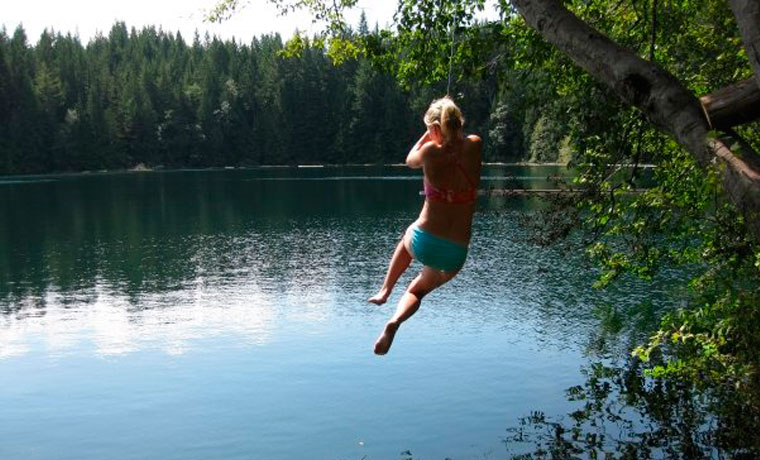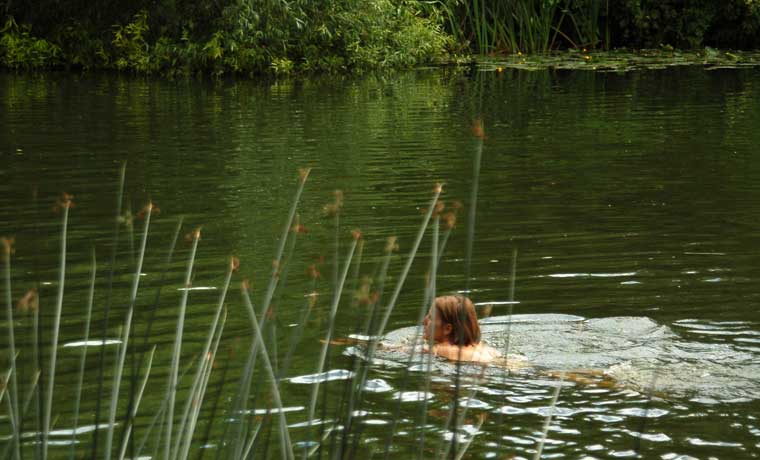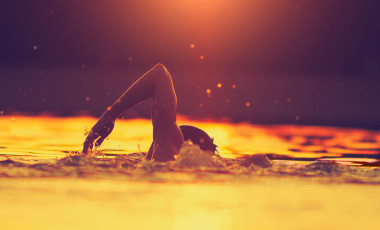I used to be terrible at swimming. Five strokes in and I’d be gasping for air and needing to stop. For someone who is relatively fit and strong in most other aspects of sport and fitness, I found this highly frustrating. Put me in a pool and I was immediately out of my depth (excuse the pun), but then one of my swimmer friends gave me a couple of swimming lessons and it changed everything. I don’t now claim to be a good swimmer by any stretch of the imagination, and I’m very slow. But I now feel really confident that I can keep going for a long time without inhaling the whole pool and ending up flopped over the edge like I’ve been in a shipwreck. So I would highly recommend being confident in a more controlled swimming environment before taking a leap into the chilly world of wild swimming.
I always loved being in the water as a kid, but this new found confidence as an adult has rekindled my need to be submerged in cool water. I am drawn to the water now – especially the wild kind. And it would seem that it’s not just me who’s getting high from swimming in cold water. It’s become a bit of a thing in the last few years, wild swimming. It’s understandable that those we label as ‘swimmers’ would want to get in any kind of water to practice their sport. But for the rest of us, what is it that makes us want to tip-toe through mud into freezing water, swim for as long as we dare before our fingers go numb and then get out? Is it really that enjoyable?

The benefits of wild swimming
Well yes! It really is (mostly) that enjoyable! Once you’ve gotten over the initial shock, there’s something about swimming in cold water that just makes you want to come back for more.
Water quality
It’s never nice getting out of the pool and having to scrub the smell of chlorine from your skin. Granted, after a swim in the wild you may have to clean some silt and mud off of you, but a bit of clean dirt never did anyone any harm. Swimming in chemical-free water also means that you will avoid itchy red eyes and damage to your hair.
Seclusion
If you choose a great spot to wild swim, it’s unlikely you will have to share that icy water with anyone else – unless you’re in the middle of a heat wave. It really is an excellent opportunity for some ‘you’ time in nature. To totally detach yourself from everyday life.
Physical health
There are numerous health benefits to swimming in cold water. Most notably, and contrary to what we might think, it is excellent for boosting the immune system. The body reacts to cold water as an attacker and therefore creates extra white blood cells ready to fend off the badies. Studies have found that after regular submersion in cold water, white blood cell count becomes significantly higher than life before regular cold water dips. Other health benefits of swimming in cold water include:
- Decreased blood pressure
- Lower cholesterol
- Increased fertility
- Inhibition of blood clotting
- Reduced fat disposition
- Improved blood circulation
Mental wellbeing
Many regular wild swimmers talk about the high they get from swimming in cold water. And it’s not just from the physical exertion. When you leap into cold water, your body releases endorphins that help to ease the initial sting from the icy chill, whilst at the same time giving you a euphoric rush. Couple that with some extra dopamine and serotonin, released in response to your parasympathetic nervous system being stimulated by cold water, and you’re guaranteed to leave the water feeling on top of the world. In fact a 2007 study found that taking regular cold showers, could be an effective treatment for depression.
Adventure
And finally, swimming in the wild is simply more adventurous that sharing your liquid space with 50 other people in an indoor pool. And in my opinion, only good things and great people come from living a more adventurous life.

13 tips to enjoy wild swimming safely
So if you’re ready to take the plunge and go swimming in cold water somewhere in the middle of nowhere, then read these top tips that will ensure the icy water doesn’t put you off for life:
1Make sure you’re a confident swimmer
If you’re not particularly great at swimming, then it’s a good idea to take a few lessons before you leap straight into a cold lake or river. Cold water can have some short-term negative physiological effects that can inhibit your ability to swim well and breath in a controlled way. Do make sure you’re really happy in a pool and your increased confidence will relax you when it comes to swimming in cold water. You’ll be ditching your pool visits in no time.
2Acclimatise
If you’ve never been wild swimming, then the best time of year to start will be during the summer when the water is at its warmest. Having the summer sun to warm you after your swim will also be super beneficial. Once you’ve gotten into the habit of swimming in cold water through the summer months, your body will start to acclimatise. Much like building up your fitness or strength, you will need to progress slowly. Soon enough your body and will deal with the chill of autumn and winter waters much more effectively than if you just went straight in for a winter wild swim without any prep.
3Don’t jump into unknown water
Who knows what might be lurking at the bottom, or indeed how deep the water is? Instead ease into the water for your first entry and check out your entry point for future leaps. Taking it slowly is also a good idea for your first few swims so as to minimise the shock of the cold.
4Don’t swim alone
You need to know that help is close at hand if you get into trouble in the water. Swimming with a small group is ideal and a much safer way to enjoy the water than with just one other person.
5Exhale as you enter the water
No matter how thorough you are with your long term acclimatisation, there’s just no getting away from the initial shock of getting into cold water. Although it does get easier the more you do it, that’s for sure. Keeping control of your breathing will help you feel a little more in control in the water, so make sure you exhale as you enter the water. The rib cage will naturally contract on first contact with chilly water making you feel very short of breath, which in turn can make you a bit panicky. An exhale works with this reaction instead of fighting against it, and then your next inhale will feel more easy and natural.
6Stick it out
If you can deal with staying in the water for 90 seconds or so, then the cold water will become much more pleasant as your body starts to adapt to the temperature change. Get moving straight away to get the blood flowing and to take your mind off the cold, and you’ll soon find things much more comfortable. It’s also a good idea to have a focus for your swim, like reaching the other side of the river, or swimming to a tree and back. Without an aim it can be all too easy to find reasons why you should just get straight out!

7Stay close to the shore
During your first few forays into cold wild waters, it’s best to stay within a few strokes of the shore or waters edge. As your body starts to cool, your ability to swim effectively can be dramatically inhibited. Your blood flow will divert away from your muscles to your organs to keep them warm. And before you know it, you can become weak and find swimming increasingly difficult. So until you know your body’s limits, it’s best to play things safe and make sure you can get out easily if you need to.
8Have warm clothes at the ready
The longer you spend swimming in cold water, the lower your body temperature will drop. So it’s essential that you have the means to get warm afterwards as quickly as possible. Move around as much as you can to get the blood moving to your extremities, and then layer up in cosy, comfortable, warm clothes that are easy to put on with frozen fingers. Have your clothing easily accessible and laid out in the order you need to put them on. Minimise the faff to maximise the warmth!
9Bring a flask of warm water for your extremities
If you are struggling to get your hands and feet warm and functioning properly, then pour some lukewarm water over them. Anything hotter than warm can be painful as the blood rushes back. Then once dry, get those thawing fingers and toes into some cosy socks and mittens.
10Eat and drink hot food
Have a flask at the ready, filled with something packed full of calories that will help to get your body back up to its normal temperature. A hot chocolate is ideal and will do wonders for the soul!
11Wear a swimming hat
If getting your head underwater gives you brain freeze, it will significantly decrease your enjoyment levels. Your head is the one part of your body that spends as much time out of the water as in it. And if there’s even a hint of breeze in the air your head can very quickly become chillier than the rest of your body. So cover it up!
12Wear booties and gloves
For swimmers with bad circulation, wearing neoprene booties and gloves might be a route to explore. Retreating from the water because you can’t feel your fingers anymore can be frustrating when the rest of your body is doing just fine. Getting them in cosy wetsuit gloves might be the solution you are looking for.
13Consider wearing a wetsuit
If you plan on swimming in cold water for any significant length of time, wearing a wetsuit should be considered. Triathlon wetsuits are designed specifically for swimming in and will give you much more freedom of movement than a surfing wetsuit. Don’t expect to be toastie in it though. You’ll still feel the chill as the icy water flushes through the suit.
So what are you waiting for? Find a wild swimming spot near you, grab your swimwear, rope in a couple of friends and pack some cosy warm clothes. It’s time to take a leap into the cold refreshing world of wild swimming!



